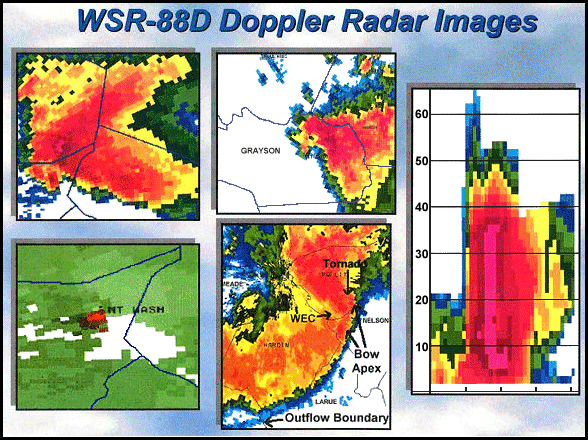Louisville, KY
Weather Forecast Office
 |
|
Upper Left: Low-level base reflectivity image of a large supercell thunderstorm that produced a damaging tornado (in the hook echo area) in northeast Bullitt County (just south of Louisville) on May 28, 1996. After this time, the storm and its tornado moved east into Spencer County. Lower Left: Low-level storm-relative velocity image of a mesocyclone (red outbound-green inbound couplet; radar located to the west/left of the area shown) in northeast Bullitt County (just southeast of Louisville) that produced a damaging tornado on May 28, 1996. Note the enhanced storm-relative inflow (area of light green color) in extreme northeast Bullitt and western Spencer Counties, along the forward flank downdraft boundary. This inflow funneled into the hook echo area and increased the strength of the low-level mesocyclone resulting in generation and maintenance of the tornado. This image corresponds to the reflectivity image in the upper left corner. Upper Center: Low-level base reflectivity image of a supercell thunderstorm that produced a damaging tornado (in the hook echo area) in Leitchfield (Grayson County), Kentucky on May 23, 2000. Lower Center: Squall line (quasi-linear convective system; QLCS) and embedded intense bow echo across north-central Kentucky on May 14, 1995. Damaging straight-line winds occurred along the bow apex (labeled), which often is positioned on the leading edge of a weak echo channel (WEC; labeled). The WEC often denotes the location of a channeled axis of higher speed winds called a rear inflow jet (RIJ) that can be responsible for producing wind damage along the leading gust front of the bow echo. Tornadoes can spin-up rapidly along and just north of the bow apex associated with small-scale mesovortices. Such vortices also concentrate a narrow swath of the most intense damage within the overall area of damage along the bow apex. The heaviest rainfall (red and orange colors) often display as an "S" shape or line echo wave pattern in organized, severe bow echoes. |
Current Hazards
Hazardous Weather Outlook
Storm Prediction Center
Submit a Storm Report
Advisory/Warning Criteria
Radar
Fort Knox
Evansville
Fort Campbell
Nashville
Jackson
Wilmington
Latest Forecasts
El Nino and La Nina
Climate Prediction
Central U.S. Weather Stories
1-Stop Winter Forecast
Aviation
Spot Request
Air Quality
Fire Weather
Recreation Forecasts
1-Stop Drought
Event Ready
1-Stop Severe Forecast
Past Weather
Climate Graphs
1-Stop Climate
CoCoRaHS
Local Climate Pages
Tornado History
Past Derby/Oaks/Thunder Weather
Football Weather
Local Information
About the NWS
Forecast Discussion
Items of Interest
Spotter Training
Regional Weather Map
Decision Support Page
Text Products
Science and Technology
Outreach
LMK Warning Area
About Our Office
Station History
Hazardous Weather Outlook
Local Climate Page
Tornado Machine Plans
Weather Enterprise Resources
US Dept of Commerce
National Oceanic and Atmospheric Administration
National Weather Service
Louisville, KY
6201 Theiler Lane
Louisville, KY 40229-1476
502-969-8842
Comments? Questions? Please Contact Us.


 Weather Story
Weather Story Weather Map
Weather Map Local Radar
Local Radar